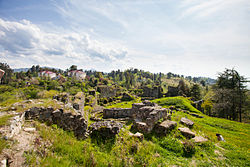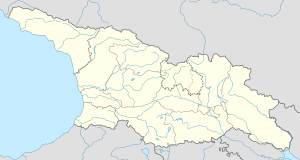Tsikhisdziri
|
Tsikhisdziri ციხისძირი |
|
|---|---|
| Village | |

Tsikhisdziri and its ruined fortress
|
|
| Location of Tsikhisdziri | |
| Coordinates: 41°45′43″N 41°45′14″E / 41.76194°N 41.75389°ECoordinates: 41°45′43″N 41°45′14″E / 41.76194°N 41.75389°E | |
| Country |
|
| Autonomous Republic |
|
| Municipality |
|
| Elevation | 440 m (1,440 ft) |
| Population (2014) | |
| • Total | 2,472 |
Tsikhisdziri (Georgian: ციხისძირი) is a village in the Kobuleti Municipality, Autonomous Republic of Adjara, Georgia, on the Black Sea coast, 8 km south of the town of Kobuleti. Tsikhisdziri is home to an archaeological site and ruins of a Late Antique fortified town, which is identified by mainstream scholarship with the Roman-built city-fortress of Petra.
The Tsikhisdziri site is located on a rocky coastline of the Black Sea, at the modern-day village. Systematic archaeological study of the site began in 1962 and yielded several layers of human settlement and various artifacts, the earliest of which date to the Late Bronze Age, when the area fell within the Colchian culture area. North of Tsikhisdziri, at Bobokvati, some 200 m from the coastline, dune-settlements, dating to the 8th century BC, were uncovered. In the following centuries, a series of ancient Greek colonies were established along the eastern Black Sea littoral. There is no literary evidence that a Greek colony existed at Tsikhisdziri, but archaeological excavations revealed the 5th-century BC burials of adults and of children in amphorae, set down into levels of earlier dune-settlement. Artifacts unearthed there include an Attic skyphos of Corinthian type and lekythos of the Haimon painter, dated to c. 470.
A collection of the 3rd-century AD items—gold jewelry, silver and bronze vessels, beads, and coins—and now known as the Tsikhisdziri treasure was found there in 1907 and then acquired by the Hermitage Museum in Saint Petersburg, Russia. Part of this collection is a rock crystal intaglio depicting a bearded man identified as the Roman emperor Lucius Verus: the design was gilded and the stone was polished to allow the image to be seen through the transparent material. The Roman presence in this area is also evidenced by a large brick found in the ruins of Tsikhisdziri with an inscription that has been interpreted as VEX[illatio]FA[siana], suggesting that that the brick—now in possession of the Janashia Museum of Georgia in Tbilisi—was made in a Roman military workshop in Phasis and shipped south.
...
Wikipedia

